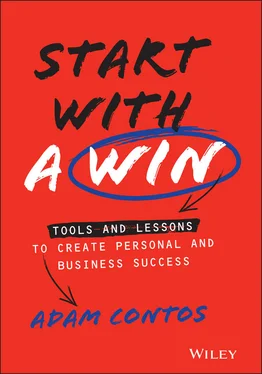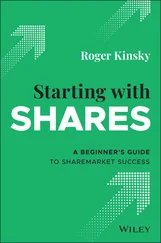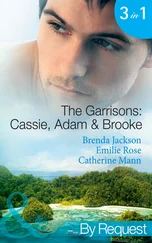That night's mission was a win. I faced the challenge, examined the options, and fortunately, without hesitation, took the actions necessary to safely solve the problem. That night also illustrates how a street cop can end up as CEO of a megacorporation.
Whatever the challenge, to solve the problem takes the right attitude and approach to every mission. That includes:
Recognize the challenge or challenges.
Meet the people involved who don't know or trust you.
Gain their trust and confidence through your attitude and actions.
Solve the problems.
THE POWER OF LEADING, NOT FOLLOWING
Actions got me to where I am today, but I promise you, those missions and those actions came with plenty of fear. That's a cost of moving forward in pursuit of wins.
“We generate fears while we sit. We overcome them by action.” 4
—Henry Link, PhD (1889–1952), psychologist
That night in the church I was scared, but I wasn't petrified. I took action because I knew I had to. I had prepared well for this, having spent long hours practicing building searches and tactical techniques, understanding potential threats on the job, and talking through all of this with my trainers.
There is a first time for everything in life; don't let that scare you away. Whether a challenge is business-related or personal, we all can learn to conquer the fear (the Beast) and earn the win by approaching problems holistically, one step at a time. That's part of being a leader.
In any situation, leaders:
Assess the situation or the problem and ask themselves, “What is the question that needs to be answered?”
Answer the question and fix the collapsed points, including weaknesses in the framework.
Understand the options available and prepare for action.
Move forward for the win.
While a deputy sheriff, I also was a part-time entrepreneur. One of the businesses I started was a security consulting firm. At the time, the early 2000s, real estate agents were being increasingly victimized—robbed, assaulted, sexually assaulted, and even murdered while doing their jobs—which was the problem I was addressing. I examined the situation and identified the security vulnerabilities they faced (assessed the problem), looked more closely at the situation, and theorized that the reasons agents were targeted—the collapsed points—included their lack of training or focus on safety. Primarily, many were unaware of their available options if they encountered bad situations, or they didn't know how to avoid them altogether and still do their jobs. They were meeting unknown people in unfamiliar places and not building any avoidance or response options into the process. Agents essentially were going where the police wouldn't go without protection, training, or a partner.
So my company came up with the answer—S.A.F.E.R. (Safety Awareness for Every REALTOR©)—a program that taught individuals the four fundamental concepts of personal safety: awareness, avoidance, de-escalation, and response if action is required.
Eventually I pitched S.A.F.E.R. to RE/MAX, and it was a big hit. More importantly, the solution helped others. S.A.F.E.R. was also my introduction to the real estate and franchising industry. I traveled around North America, speaking to agents and brokers and learning about their industry and challenges. It turned out that many of their challenges weren't safety issues; rather, they were business issues that put them in poor safety situations. Remember, success lies in deconstructing the challenges into smaller, more manageable pieces, and then fixing the problems one at a time.
About a year after instituting the S.A.F.E.R. program, RE/MAX asked me to join the company as a franchise consultant. It meant a pay cut and leaving law enforcement—at the time I was a SWAT leader—as well as trying something new and different. Momentarily my Beast—fear of the unknown—reared its head. Others told me I was making a big mistake by leaving law enforcement. But I believed in my abilities, as did my friend and mentor Dave Liniger. I also recognized that, at best, this move could be a new career and, at second best, an incredible learning experience. Beast be damned.
The first time I addressed a large crowd—1,500 people—I was nervous and a little afraid. I understood suddenly why so many people are afraid of public speaking. Like many public speakers before they go on stage, I worried about a number of issues: whether people would listen to me, whether they would care about what I had to say, whether my message would be clear, whether I would embarrass myself, and all those other little and not-quite-so-little fears that can nag at each of us.
A mission.But I approached my speech as another mission, and that enabled me to separate it from my fear—the Beast. It's the same approach I used as a SWAT officer or on a sheriff's call. I had a script and I knew the mission; I had practiced the speech many times, and so I walked on stage confident that I could do the job right, and I did.
Nearly two decades and literally thousands of presentations later, I still get a little nervous. I consider it my quality-control awareness. But today, just as then, I know my material, practice my presentation over and over and over again, and address people I care about, so my words come across as genuine and caring. Admittedly though, my speeches are a little more comfortable and conversational now as opposed to those early speeches.
Everyone thinks there's a secret to public speaking, but there's not. Faced with presenting, follow the principles above for a win. Repeated practice is essential to familiarize yourself with the content. Too many people try to script too many things. But audiences don't want a scripted talk. They don't want you to read; they prefer a free-flowing conversation, which requires knowledge of the ideas so they can be shared easily, freely, and comfortably.
It's the same procedure for video presentations. Audiences want to hear and see confidence, a positive attitude, and kindness or caring.
Study and practice.I learned to improve my speech delivery by reading how great public speakers do it. I also watched videos of other amazing public speakers—not for the content or the delivery methodology, but for the tone, tempo, delivery, and how the speaker reads their audience. It's called public speaking and not public talking for a reason. You're communicating as if you're having a two-way conversation, only the feedback from the crowd is in their response, not their words.
Seek comment.Feedback from a presentation also allows us to continually learn and improve. Despite all the speeches I've made over the years, I still seek out and appreciate feedback after every speech or presentation. I have had speaking consultants critique my work and rip it apart. It hurts to hear your mistakes, but you listen, learn, and improve. I also review video or audio of my presentations. I don't like to watch myself present—I don't think anyone does—but I do it to see if there are ways I can improve for next time.
Reviewing the product of your work is important in whatever we do, whether it's a speech, a sale, a document, or a mission in your life. When my wife and I leave the gym in the morning, we even discuss our workouts and how to make them better—or we celebrate our victories.
If we ignore pursuing excellence in one thing, we ignore it in everything. That goes for shooting a two-minute video on social media all the way to standing in front of 10,000 people to deliver a speech.
WINNING IN UNCERTAIN TIMES
Читать дальше












